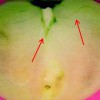 What is a rapid postharvest decay? Water-soaked lesions begin within 12 to 18 hours after harvest and continue to develop, producing large amounts of fluids. The decay spreads within cartons of tomatoes, producing wet patches in the bottom and sides of the container, a condition called “wet-boxes.” Affected fruit are out-of-grade either prior to shipment or upon arrival at the receiver.This 5-page fact sheet was written by J. A. Bartz, S. A. Sargent, and D. J. Huber, and published by the UF Department of Horticultural Sciences, December 2014. (Photo: S. R. Bartz)
What is a rapid postharvest decay? Water-soaked lesions begin within 12 to 18 hours after harvest and continue to develop, producing large amounts of fluids. The decay spreads within cartons of tomatoes, producing wet patches in the bottom and sides of the container, a condition called “wet-boxes.” Affected fruit are out-of-grade either prior to shipment or upon arrival at the receiver.This 5-page fact sheet was written by J. A. Bartz, S. A. Sargent, and D. J. Huber, and published by the UF Department of Horticultural Sciences, December 2014. (Photo: S. R. Bartz)
http://edis.ifas.ufl.edu/hs363
Tag: Jerry A. Bartz
A Postharvest Fruit Rot Caused by Alternaria sp. on Imported Plum Tomatoes in South Florida (PP303)
 Florida’s deep-water ports are ideal for importing many fruits and vegetables, including tomatoes, by ship from the Caribbean as well as Central and South American production areas. These imports are often strictly regulated for pests, but some pathogens still escape quarantine. This 3-page fact sheet describes a postharvest problem on plum tomatoes that were imported from Mexico through South Florida in 2010. Alternaria sp. was isolated from lesions on diseased fruits, pathogenicity tests were conducted on healthy fruits, and symptoms identical to the originally submitted samples were developed. Written by Zelalem Mersha, Shouan Zhang,and Jerry A. Bartz, and published by the UF Department of Plant Pathology, January 2013.
Florida’s deep-water ports are ideal for importing many fruits and vegetables, including tomatoes, by ship from the Caribbean as well as Central and South American production areas. These imports are often strictly regulated for pests, but some pathogens still escape quarantine. This 3-page fact sheet describes a postharvest problem on plum tomatoes that were imported from Mexico through South Florida in 2010. Alternaria sp. was isolated from lesions on diseased fruits, pathogenicity tests were conducted on healthy fruits, and symptoms identical to the originally submitted samples were developed. Written by Zelalem Mersha, Shouan Zhang,and Jerry A. Bartz, and published by the UF Department of Plant Pathology, January 2013.
http://edis.ifas.ufl.edu/pp303
Postharvest Quality and Decay Incidence among Tomato Fruit as Affected by Weather and Cultural Practices. (PP294)
 Postharvest decay losses for field-grown, fresh-market tomatoes are usually associated with harvests that occur when fields are wet and warm. During periods of persistently wet fields, decay pathogens infect damaged fruit on the plant as well as injuries to petioles and stems. Review of all reports and photos implicated excessive water in fruit rather than air temperatures as the primary predisposition. Excessive water in fruit is possible at virtually any time of the season and can appear at times of cold as well as warm field temperatures. This 8-page fact sheet was written by Jerry A. Bartz, Steven A. Sargent, and John W. Scott, and published by the UF Department of Plant Pathology, July 2012.
Postharvest decay losses for field-grown, fresh-market tomatoes are usually associated with harvests that occur when fields are wet and warm. During periods of persistently wet fields, decay pathogens infect damaged fruit on the plant as well as injuries to petioles and stems. Review of all reports and photos implicated excessive water in fruit rather than air temperatures as the primary predisposition. Excessive water in fruit is possible at virtually any time of the season and can appear at times of cold as well as warm field temperatures. This 8-page fact sheet was written by Jerry A. Bartz, Steven A. Sargent, and John W. Scott, and published by the UF Department of Plant Pathology, July 2012.
http://edis.ifas.ufl.edu/pp294